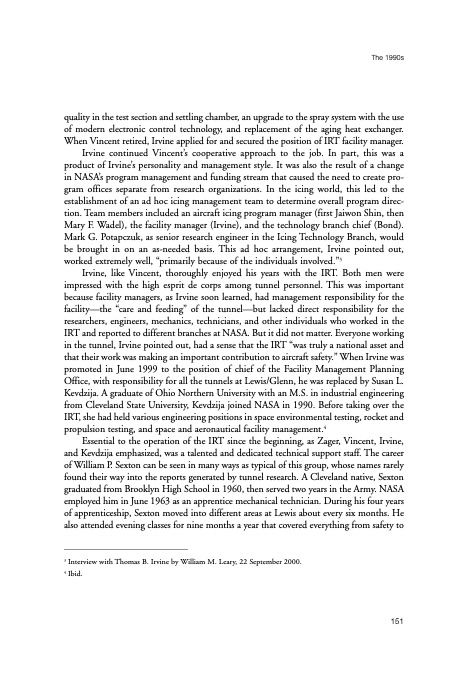
PDF Publication Title:
Text from PDF Page: 162
quality in the test section and settling chamber, an upgrade to the spray system with the use of modern electronic control technology, and replacement of the aging heat exchanger. When Vincent retired, Irvine applied for and secured the position of IRT facility manager. Irvine continued Vincent’s cooperative approach to the job. In part, this was a product of Irvine’s personality and management style. It was also the result of a change in NASA’s program management and funding stream that caused the need to create pro- gram offices separate from research organizations. In the icing world, this led to the establishment of an ad hoc icing management team to determine overall program direc- tion. Team members included an aircraft icing program manager (first Jaiwon Shin, then Mary F. Wadel), the facility manager (Irvine), and the technology branch chief (Bond). Mark G. Potapczuk, as senior research engineer in the Icing Technology Branch, would be brought in on an as-needed basis. This ad hoc arrangement, Irvine pointed out, worked extremely well, “primarily because of the individuals involved.”3 Irvine, like Vincent, thoroughly enjoyed his years with the IRT. Both men were impressed with the high esprit de corps among tunnel personnel. This was important because facility managers, as Irvine soon learned, had management responsibility for the facility—the “care and feeding” of the tunnel—but lacked direct responsibility for the researchers, engineers, mechanics, technicians, and other individuals who worked in the IRT and reported to different branches at NASA. But it did not matter. Everyone working in the tunnel, Irvine pointed out, had a sense that the IRT “was truly a national asset and that their work was making an important contribution to aircraft safety.” When Irvine was promoted in June 1999 to the position of chief of the Facility Management Planning Office, with responsibility for all the tunnels at Lewis/Glenn, he was replaced by Susan L. Kevdzija. A graduate of Ohio Northern University with an M.S. in industrial engineering from Cleveland State University, Kevdzija joined NASA in 1990. Before taking over the IRT, she had held various engineering positions in space environmental testing, rocket and propulsion testing, and space and aeronautical facility management.4 Essential to the operation of the IRT since the beginning, as Zager, Vincent, Irvine, and Kevdzija emphasized, was a talented and dedicated technical support staff. The career of William P. Sexton can be seen in many ways as typical of this group, whose names rarely found their way into the reports generated by tunnel research. A Cleveland native, Sexton graduated from Brooklyn High School in 1960, then served two years in the Army. NASA employed him in June 1963 as an apprentice mechanical technician. During his four years of apprenticeship, Sexton moved into different areas at Lewis about every six months. He also attended evening classes for nine months a year that covered everything from safety to The 1990s 3 Interview with Thomas B. Irvine by William M. Leary, 22 September 2000. 4 Ibid. 151PDF Image | History of NASA Icing Research Tunnel

PDF Search Title:
History of NASA Icing Research TunnelOriginal File Name Searched:
sp4226.pdfDIY PDF Search: Google It | Yahoo | Bing
NFT (Non Fungible Token): Buy our tech, design, development or system NFT and become part of our tech NFT network... More Info
IT XR Project Redstone NFT Available for Sale: NFT for high tech turbine design with one part 3D printed counter-rotating energy turbine. Be part of the future with this NFT. Can be bought and sold but only one design NFT exists. Royalties go to the developer (Infinity) to keep enhancing design and applications... More Info
Infinity Turbine IT XR Project Redstone Design: NFT for sale... NFT for high tech turbine design with one part 3D printed counter-rotating energy turbine. Includes all rights to this turbine design, including license for Fluid Handling Block I and II for the turbine assembly and housing. The NFT includes the blueprints (cad/cam), revenue streams, and all future development of the IT XR Project Redstone... More Info
Infinity Turbine ROT Radial Outflow Turbine 24 Design and Worldwide Rights: NFT for sale... NFT for the ROT 24 energy turbine. Be part of the future with this NFT. This design can be bought and sold but only one design NFT exists. You may manufacture the unit, or get the revenues from its sale from Infinity Turbine. Royalties go to the developer (Infinity) to keep enhancing design and applications... More Info
Infinity Supercritical CO2 10 Liter Extractor Design and Worldwide Rights: The Infinity Supercritical 10L CO2 extractor is for botanical oil extraction, which is rich in terpenes and can produce shelf ready full spectrum oil. With over 5 years of development, this industry leader mature extractor machine has been sold since 2015 and is part of many profitable businesses. The process can also be used for electrowinning, e-waste recycling, and lithium battery recycling, gold mining electronic wastes, precious metals. CO2 can also be used in a reverse fuel cell with nafion to make a gas-to-liquids fuel, such as methanol, ethanol and butanol or ethylene. Supercritical CO2 has also been used for treating nafion to make it more effective catalyst. This NFT is for the purchase of worldwide rights which includes the design. More Info
NFT (Non Fungible Token): Buy our tech, design, development or system NFT and become part of our tech NFT network... More Info
Infinity Turbine Products: Special for this month, any plans are $10,000 for complete Cad/Cam blueprints. License is for one build. Try before you buy a production license. May pay by Bitcoin or other Crypto. Products Page... More Info
| CONTACT TEL: 608-238-6001 Email: greg@infinityturbine.com | RSS | AMP |